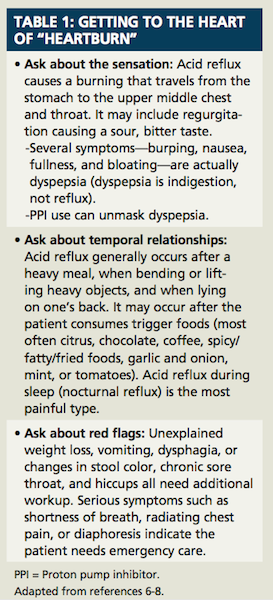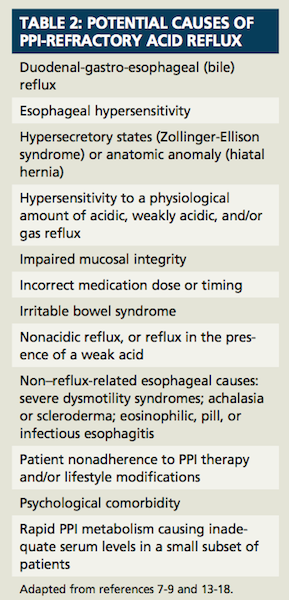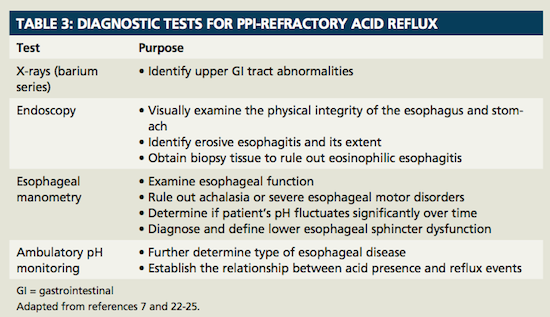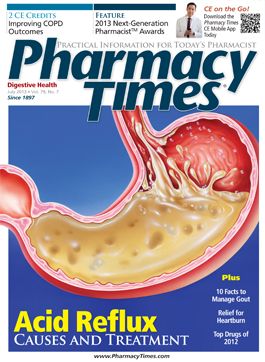PPI-Refractory Acid Reflux: What's Next?
PPI therapy fails either partially or completely in up to 30% of patients. Pharmacists can help identify a cause and choose a course of action.
PPI therapy fails either partially or completely in up to 30% of patients. Pharmacists can help identify a cause and choose a course of action.
Proton pump inhibitors (PPIs) have become our go-to drugs for acid reflux patients. Pharmacists—and patients, too—expect that PPIs will resolve the burning, sour reflux quickly. PPI therapy fails either partially or completely, however, for up to 30% of patients.1,2 Patients routinely return to their pharmacist complaining of “heartburn” or other symptoms.
Gastroenterologists have yet to establish a consistent definition of PPI-refractory acid reflux, but common elements include less than 50% improvement in the patient’ s chief complaint after at least 12 weeks of twice-daily PPI therapy. (This is a larger dose than the FDA currently approves; see below.) PPI-refractory acid reflux symptoms must impair quality of life. These symptoms must also be reflux-related, which is difficult to determine without further testing since symptoms can be related to acid reflux, gas reflux, or functional complications. Clinicians must ask about specific symptoms (Table 1) because patients often complain of continuing or residual “heartburn,” which is a vague term that can indicate multiple conditions.3-5
What’s Happening?
Researchers have identified many mechanisms for PPI-refractory reflux (Table 2). Patients who have dyspepsia or regurgitation are more likely to be PPI-refractory,8,9 as are those who have anxiety disorders or depression. Patients who have psychosocial comorbidities are also more likely to be nonresponsive to PPIs, and conversely, patients who respond incompletely to PPI treatment are more likely to experience psychological distress.10-13

Patients who report PPI-nonresponsiveness are often nonadherent.19 When a standard once-daily PPI dose is unsuccessful despite patient adherence, physicians often double the dose, prescribing the approved dose before breakfast and then again at dinner. No large studies support this approach, but some smaller studies suggest it is a rational choice. Experts estimate that about 30% of patients refractory to a once-daily dose will respond to a doubled dose. After 8 to 12 weeks of treatment, prescribers can begin to reduce the dose to once-daily therapy. Most patients will then be controlled on once-daily therapy, and a few may discontinue the PPI completely.20
Some research suggests that switching to a different PPI can increase the chance of a response.21 At some point, either before or while making these changes, the clinician will probably use additional testing (Table 3) to determine if something else is causing continuing symptoms.
Next Steps
Depending on test results and the patient’s response to a PPI dose increase or a PPI switch, prescribers have several ways to proceed. If the patient’s problem is documented as real acid reflux disease (and not a different condition requiring different interventions), inevitably the prescriber and health care team review and reinforce the need for lifestyle modifications. Patients who are PPI-refractory often have not made lifestyle modifications and need to be reminded. Helpful lifestyle modifications include losing weight, elevating the head of the bed during sleep, and avoiding late-night meals.19,26,27

Augmenting PPI therapy can help, and many patients do this spontaneously by adding an OTC antacid without a doctor’s recommendation. Alginates seem to be particularly effective.28 Adding a histamine receptor antagonist (H2RA) at bedtime can also reduce breakthrough acid reflux. Resistance to H2RA is now well documented, and some prescribers advise patients to take H2RA as needed or intermittently.29
If transient lower esophageal sphincter relaxation is suspected, baclofen is sometimes used at doses of 5 to 20 mg 3 times a day.30 Side effects such as dizziness, sedation, nausea, and vomiting often limit baclofen’s use.
If hypersensitivity to normal levels of acid is suspected, tricyclic antidepressants, trazodone, and selective serotonin reuptake inhibitors have been used to reduce esophageal pain.5
Some patients may need anti-reflux surgery (laparoscopic fundoplication), but it may be more effective in PPI-responsive patients than in PPI-refractory patients.31
Concerns and Conclusion
As off-label and long-term PPI use grows and changes, many clinicians have expressed concern about side effects. Numerous studies are under way that examine new dosing schedules, treatment duration, and potential therapy complications. Pharmacists will need to stay abreast of changes.

Ms. Wick is a visiting professor at the University of Connecticut School of Pharmacy and a freelance writer from Virginia.
References:
- Organization TG. The 2000 Gallup Study of Consumers’ Use of Stomach Relief Products. Princeton, NJ: Gallup Organization; 2000.
- Carlsson R, Dent J, Watts R, et al. Gastro-oesophageal reflux disease in primary care: an international study of different treatment strategies with omeprazole. International GORD Study Group. Eur J Gastroenterol Hepatol. 1998;10:119-124.
- Fass R. Alternative therapeutic approaches to chronic proton pump inhibitor treatment. Clin Gastroenterol Hepatol. 2012;10:338-345.
- Bredenoord AJ, Smout AJ. Refractory gastrooesophageal reflux disease. Eur J Gastroenterol Hepatol. 2008;20:217-223.
- Fass R, Sifrim D. Management of heartburn not responding to proton pump inhibitors. Gut. 2009;58:295-309.
- Dellon ES, Shaheen NJ. Persistent reflux symptoms in the proton pump inhibitor era: the changing face of gastroesophageal reflux disease. Gastroenterology. 2010;139:7-13.
- Bautista JM, Wong WM, Pulliam G, Esquivel RF, Fass R. The value of ambulatory 24 hr esophageal pH monitoring in clinical practice in patients who were referred with persistent gastroesophageal reflux disease (GERD)-related symptoms while on standard dose anti-reflux medications. Dig Dis Sci. 2005;50:1909-1915.
- Kahrilas PJ, Howden CW, Hughes N. Response of regurgitation to proton pump inhibitor therapy in clinical trials of gastroesophageal reflux disease. Am J Gastroenterol. 2011;106:1419-1425.
- Vela MF, Camacho-Lobato L, Srinivasan R, Tutuian R, Katz PO, Castell DO. Simultaneous intraesophageal impedance and pH measurement of acid and nonacid gastroesophageal reflux: effect of omeprazole. Gastroenterology. 2001;120:1599-1606.
- Fass R, Naliboff BD, Fass SS, et al. The effect of auditory stress on perception of intraesophageal acid in patients with gastroesophageal reflux disease. Gastroenterology. 2008;134:696-705.
- Taché Y, Perdue MH. Role of peripheral CRF signaling pathways in stress-related alterations of gut motility and mucosal function. Neurogastroenterol Motil. 2004;16(suppl 1):137-142.
- Sharma A, Van Oudenhove L, Paine P, Gregory L, Aziz Q. Anxiety increases acid-induced esophageal hyperalgesia. Psychosom Med. 2010;72:802-809.
- Becher A, El-Serag H. Systematic review: the association between symptomatic response to proton pump inhibitors and health-related quality of life in patients with gastro-oesophageal reflux disease. Aliment Pharmacol Ther. 2011;34:618-627.
- Sifrim D. Acid, weakly acidic and non-acid gastro-oesophageal reflux: differences, prevalence and clinical relevance. Eur J Gastroenterol Hepatol. 2004;16:823-830.
- Marshall RE, Anggiansah A, Owen WA, Owen WJ. The relationship between acid and bile reflux and symptoms in gastro-oesophageal reflux disease. Gut. 1997;40:182-187.
- Galmiche JP, Clouse RE, Bálint A, et al. Functional esophageal disorders. Gastroenterology. 2006;130:1459-1465.
- Thoua NM, Khoo D, Kalantzis C, Emmanuel AV. Acid-related oesophageal sensitivity, not dysmotility, differentiates subgroups of patients with non-erosive reflux disease. Aliment Pharmacol Ther. 2008;27:396-403.
- Nojkov B, Rubenstein JH, Adlis SA, et al. The influence of co-morbid IBS and psychological distress on outcomes and quality of life following PPI therapy in patients with gastro-oesophageal reflux disease. Aliment Pharmacol Ther. 2008;27:473-482.
- Dickman R, Boaz M, Aizic S, Beniashvili Z, Fass R, Niv Y. Comparison of clinical characteristics of patients with gastroesophageal reflux disease who failed proton pump inhibitor therapy versus those who fully responded. J Neurogastroenterol Motil. 2011;17:387-394.
- Inadomi JM, McIntyre L, Bernard L, Fendrick AM. Step-down from multiple- to single-dose proton pump inhibitors (PPIs): a prospective study of patients with heartburn or acid regurgitation completely relieved with PPIs. Am J Gastroenterol. 2003;98:1940-1944.
- Fass R, Murthy U, Hayden CW, et al. Omeprazole 40 mg once a day is equally effective as lansoprazole 30 mg twice a day in symptom control of patients with gastro-oesophageal reflux disease (GERD) who are resistant to conventional-dose lansoprazole therapy-a prospective, randomized, multi-centre study. Aliment Pharmacol Ther. 2000;14:1595-1603.
- Charbel S, Khandwala F, Vaezi MF. The role of esophageal pH monitoring in symptomatic patients on PPI therapy. Am J Gastroenterol. 2005;100:283-289.
- Poh CH, Gasiorowska A, Navarro-Rodriguez T, et al. Upper GI tract findings in patients with heartburn in whom proton pump inhibitor treatment failed versus those not receiving antireflux treatment. Gastrointest Endosc. 2010;71:28-34.
- Ponce J, Ortiz V, Maroto N, Ponce M, Bustamante M, Garrigues V. High prevalence of heartburn and low acid sensitivity in patients with idiopathic achalasia. Dig Dis Sci. 2011;56:773-776.
- Hirano I, Richter JE; Practice Parameters Committee of the American College of Gastroenterology. ACG practice guidelines: esophageal reflux testing. Am J Gastroenterol. 2007;102:668-685.
- De Groot NL, Burgerhart JS, Van De Meeberg PC, de Vries DR, Smout AJ, Siersema PD. Systematic review: the effects of conservative and surgical treatment for obesity on gastro-oesophageal reflux disease. Aliment Pharmacol Ther. 2009;30:1091-1102.
- Kaltenbach T, Crockett S, Gerson LB. Are lifestyle measures effective in patients with gastroesophageal reflux disease? an evidence-based approach. Arch Intern Med. 2006;166:965-971.
- Manabe N, Haruma K, Ito M, et al. Efficacy of adding sodium alginate to omeprazole in patients with nonerosive reflux disease: a randomized clinical trial. Dis Esophagus. 2012;25:373-380.
- Xue S, Katz PO, Banerjee P, Tutuian R, Castell DO. Bedtime H2 blockers improve nocturnal gastric acid control in GERD patients on proton pump inhibitors. Aliment Pharmacol Ther. 2001;15:1351-1356.
- Vela MF, Tutuian R, Katz PO, Castell DO. Baclofen decreases acid and non-acid post-prandial gastro-oesophageal reflux measured by combined multichannel intraluminal impedance and pH. Aliment Pharmacol Ther. 2003;17:243-251.
- Lundell L. Surgical therapy of gastro-oesophageal reflux disease. Best Pract Res Clin Gastroenterol. 2010;24:947-959.

